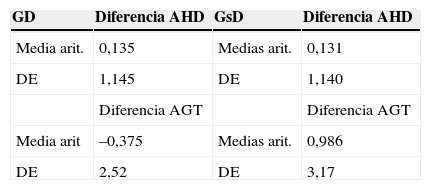Observar la implicación que tiene el espacio subacromial medido ecográficamente, y si existen diferencias entre el acromio great trocanter (AGT) y el acromio humeral distance (AHD) en deportistas con dolor de hombro.
Material y métodoSe ha realizado un estudio observacional, transversal y comparativo sobre la relación del espacio subacromial y el dolor del hombro del deportista lanzador. Se ha seleccionado a 81 deportistas hombres que utilizan los miembros superiores en su práctica deportiva. Se les practicó una ecografía del hombro obteniendo imágenes de la distancia AGT y la distancia AHD. La muestra se dividió en 2 grupos en función del dolor durante la práctica deportiva.
ResultadosNo se encontraron diferencias estadísticamente significativas en AHD, AGT, diferencia en la AHD entre el grupo sin dolor (GsD) y el grupo con dolor (GD). Sin embargo, se obtuvieron diferencias significativas para la edad (p=0,010; IC del 95%, –8,41; –1) y para la diferencia en la AGT (p=0,039; IC del 95%, 0,068-2,654). Se encontró una correlación significativa (GsD, p=0,007; GD, p=0,013) entre la AGT y la AHD aunque con una dependencia moderada (GsD r=0,395; GD r=0,412).
ConclusionesLa distancia AGT es significativamente menor en los sujetos con dolor de hombro y la distancia AHD tiene tendencia a estar disminuida en presencia de dolor. A su vez, la edad es un factor predisponente del dolor de hombro en deportistas. Por lo que se recomienda el estudio de estos valores como dato complementario en la valoración ecográfica del conflicto subacromial.
To observe the involvement of the subacromial space measured by ultrasound and if there are any differences between AGT (Acromio Great Trocanter) and AHD (Acromio Humeral Distance) in the group of patients with and without shoulder pain.
Material and methodAn observational, cross-sectional and comparative study on the relationship of subacromial space and shoulder pain in overhead sportmen was performed. A total of 81 sportmen who used their Upper Limbs in their sport were selected. A shoulder ultrasound that obtained images of AGT distance and distance AHD was performed. The sample was divided into two groups based on pain during sports.
ResultsNo statistically significant differences were found in the AHD, AGT, the AHD or a difference between the no pain group (NPG) and the pain group (PG). However, significant differences for age (P=0.010; CI 95% -8.41 -1) and for the AGT (p=0.039; CI 95% 0.068 - 2.654) were obtained. A significant correlation (PG, P=0.013; NPG, P=0.007) was found between AGT and AHD with moderate dependence (NPG r = 0.395; PG r = 0.412).
ConclusionsThe AGT distance is significantly lower in subjects with shoulder pain and AHD distance tends to be decreased in the presence of pain. Age is also a predisposing factor of shoulder pain in sportmen. That is why the study of these values as additional data on the ultrasound assessment of subacromial impingement is recommended.
Artículo
Si ya tiene sus datos de acceso, clique aquí.
Si olvidó su clave de acceso puede recuperarla clicando aquí y seleccionando la opción "He olvidado mi contraseña".Comprando el artículo el PDF del mismo podrá ser descargado
Precio 19,34 €
Comprar ahora
















